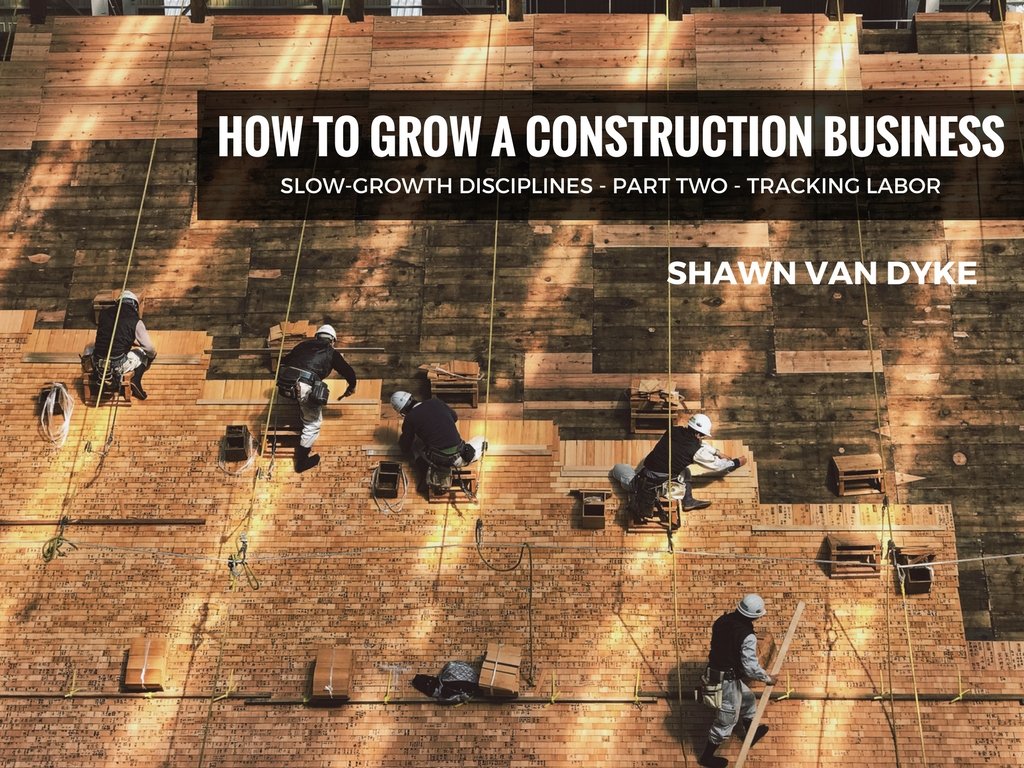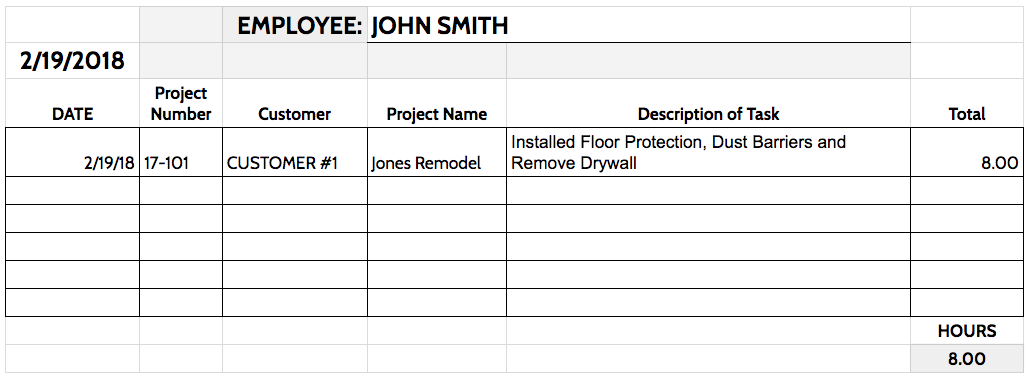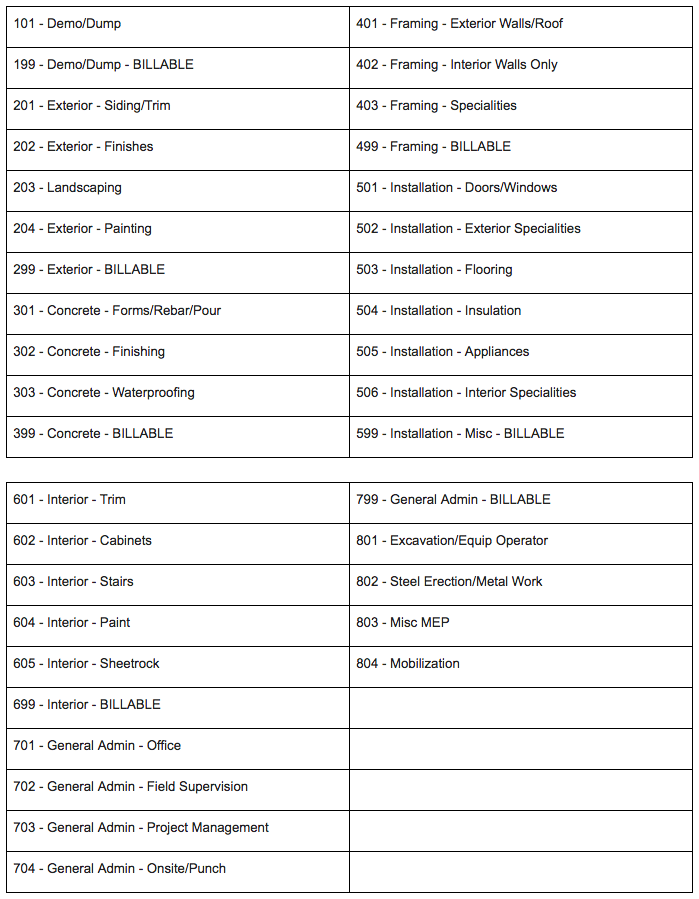Built to Build: Blog
DISCIPLINES TO GROW A CONSTRUCTION BUSINESS – PART TWO

In part 2 of this series, I am going to show you a simple method to measure your labor.
Labor is usually the largest cost for a construction business. If you don’t measure your labor in the same way in which you estimate it, you’ll never know if you’re making a profit on your largest cost.
Implementing this labor tracking system will take time. You have to develop the tracking system (Billing Codes), train your employees on how to fill out their time cards, and develop a system to analyze the results.
This is the second of four “Slow-Growth Disciplines” that will help you grow your construction business.
DISCIPLINE 2 – TRACKING LABOR USING BILLING CODES
Construction projects start with an estimate or proposal for the scope of work.
This scope of work is developed line item by line item and a cost is associated with each line item.
Each line item will consist of one or a combination of the following costs:
- Labor
- Materials
- Subcontractors
- Equipment
Estimating the correct amount of labor for each task is a skill that takes time and experience to develop.
As I wrote about in a previous article, communicating the LABOR BUDGET is vital to achieving the production goals of your project.
But communicating the LABOR BUDGET to your team will not lead to growth if you do not also track the labor spent on the project.
DESIGN A BILLING CODE SYSTEM
Each labor line item in your proposal has a quantity of man-hours associated with it.
A Billing Code system assigns a unique identifier (a number) to each of the tasks on the proposal. When your employees spend time on that task, they report that time on their time cards according to the Billing Code assigned to that task.
For example:
Let’s say that you are a remodeling contractor and the items below are self-performed by your crew as Phase One of a project.
DEMO PHASE:
- Install Floor Protection – 4 man-hours
- Install Dust Barriers – 3 man-hours
- Install Temporary Walls – 10 man-hours
- Remove Drywall – 10 man-hours
- Remove Interior Walls – 8 man-hours
You have estimated 37 total man-hours to complete the scope items listed above.
How can you determine if the estimated Labor Budget for this phase of work is met?
You have to track the time spent on each of these items individually.
The simplest way to do that is to assign BILLING CODES to each of the line items and have your crew members note that on their time cards.
Example of Billing Codes for the DEMO PHASE
Since the items listed above are fairly standard line items for any remodeling project, you should develop a standard list of Billing Codes associated with these items.
For Example, the Billing Codes for these items may be:
- 201 Install Floor Protection 4 man-hours
- 202 Install Dust Barriers 3 man-hours
- 203 Install Temporary Walls 10 man-hours
- 204 Remove Drywall 10 man-hours
- 205 Remove Interior Walls 8 man-hours
With Billing Codes assigned to each line item, your employees can now track their time spent on each task.
Instead of turning in a time card that looks like this:

You can have your employee provide you with a more accurate description of his day.

When you assign Billing Codes to each line item in your estimate and have your employees track their time spent on each task, then you will know exactly where your estimate is inaccurate or where your production may have been delayed or exceeded.
Using Standard Billing Codes will simplify the process of filling out time cards.
Your employees won’t have to write out a description of the task because the Billing Code number will tell you what the task is. There’s no need for further explanation.
Publish your Billing Codes to your employees and have them “clock in” and “clock out” according to these codes.
Once you have developed your Standard Billing Codes, then you can start tracking the time spent on each task for each project for each employee.
Here’s an example of Billing Codes for a General Contractor:
When you produce proposals using your Standard Billing Code items, then you can track the accuracy of your proposal during the production phase when your employees log their time according to the Billing Codes for each task.
This will show you exactly where you are making money (hitting your numbers) and where you are losing money (missing your numbers).
ANALYSING YOUR LABOR BUDGETS
There are several time-tracking options for your construction business.
There’s the “old-school” method of filling out a paper time card.
You can also use a mobile time-tracking application or comprehensive project management software to create a digital record of time spent on each task.
Once you have your time assigned to your Billing Code system, then you can produce a database of the time spent on each project.
If you aren’t using a digital time card system, then you may want to develop a spreadsheet where you can summarize this information for further analysis.
Most mobile or digital time card systems will have this functionality built into the system.
Whether you go “analog” or digital with your time tracking system, establishing a Billing Code system is the key to accurate job costing.
If you aren’t tracking your employees’ time in the same way you are estimating their time, then you won’t know where you are winning and where you are losing.
I have created a free online course that shows you how to use Google Sheets to create a digital time card system.
Click here to sign up for the free training.
Implementing a Billing Code and time tracking system will help identify where you are making money and where you are losing money.
And one of the simplest ways to grow your construction business is to stop doing the things that don’t make you money and focus on the things that do.
If you want to streamline your construction business and DOUBLE your profits next month…

Shawn Van Dyke is a construction industry consultant, business coach, and mentor to skilled trade business owners. He is a Brand Ambassador for Fine Homebuilding, travels across the US as a keynote speaker, seminar presenter, and the author of The Paperwork Punch List: 28 Days to Streamline Your Construction Business.
WANT SHAWN TO SPEAK AT YOUR EVENT OR TRAIN YOUR TEAM?

